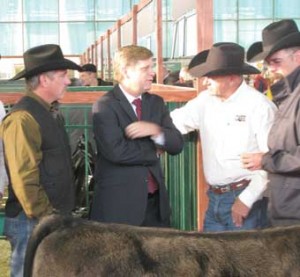
South Dakota is latest to visit country, talk cattle trade
By Codi Vallery-Mills
Thousands of live cattle cross the ocean each year to be placed into Russian cattle operations from the United States. The US Department of Commerce reports 61,000 head left the U.S. for Russia between May 2011and May 2012. Cattlemen in the region, like Eldon Krebs in Nebraska and Darrell Stevenson in Montana, are among the pioneers who have successfully shipped cattle to the old USSR.
There will continue to be opportunity for American cattle operations to supply cattle genetics to Russia’s cattle industry, as it is just in its infancy. Because of this, the South Dakota Department of Agriculture conducted a trade mission of sorts to the country in October. Ty Eschenbaum, value-added marketing specialist with the department, was joined by Kelly Bruns a professor of animal science at South Dakota State University, and Troy Thomas of the Thomas Ranch, Harrold, S.D.
The fact that Russia is in the beginning stages of cattle production was evident for Thomas.
“There is a vast difference in the number of cattle, as well as size and management of the herds there,” says Thomas of what he saw.
Also lacking is infrastructure. Since the fall of communism in the 90s, the government owned, collective farms have been divided up and done away with. The buildings are now run down, roads are inadequate and equipment is modest.
The terrain is similar to central Minnesota. Forested areas in some places and then open grasslands in others. Eschenbaum, Bruns and Thomas spent 10 days in Russia, based in Moscow and traveling into the countryside from there. A 200 mile trip could easily take them all day because of the poor roads and traffic.
They met with local farmers, businessmen, butchers, and herd managers of a few of the U.S. oriented cattle herds.
For Thomas, “seeing American cattle in Russia, and the huge potential for more
exports and expansion of the cattle industry there,” was the highlight of the trip.
It isn’t just genetic resources the country needs though as Bruns points out. He says there is a need for knowledge in reproduction, herd management, nutrition and meat science.
There are a few on farm butcher operations in the countryside. Many of them harvest 1-2 animals weekly and sell them locally or in nearest town.
In 2013 and 2014 two meatpacking plants are to come online in Russia. However, they will need the cattle and the education to meet the demand for supply and quality.
“The country will have to import beef yet,” says Bruns of the impact on imports. “I don’t see them being sufficient for 10-15 years. Their beef herd number is less than a half a million beef cows, which is only a third of the beef cows we have in South Dakota, that being the case, they need to rebuild the herd to be sustainable. It will take them a while for them to rebuild. ”
In regards to herd management, many of the cattle ranches there, have sought out American cowboys to oversee and educate their work force.
“If you are energetic and don’t mind being isolated there is huge opportunity for young people to work with cattle in Russia,” says Bruns.
Angus Genetics, Russia’s largest cattle operation to date with 16 ranches, 60,000 cattle and 60 managers while Miratorg Ranch has plans to double in size in the near future.
One of the Miratorg managers is Anthony Stidham a rancher from Oklahoma. In talking to Stidham it was brought home that Russia’s government is invested in building it’s beef business into the future. Opportunity is abundant.
“On top of live cattle genetics, there will also be potential to ship semen and embryos but even more than that, there will be opportunity for nutrition managers, herd management, vet medicine – all industries that support the cattle industry – to do business in Russia,” says Eschenbaum
And what does all this opportunity mean for Russia? According to Bruns the establishment of a beef cattle sector there means huge things.
“The cattle industry will enable the Russian people who have not had a lot of opportunity for jobs, establish themselves by working for someone, or themselves, and make a nice income. In many areas we observed what could be considered subsistence agriculture, where small villages consumed all of what they raised,” says Bruns.
According to Eschenbaum a return trip in 2013 is on the books, but does depend on what the Farm Bill looks like in 2013. Regardless, the department plans to offer their new Russian contacts assistance in supplying the resources they need. Or, says Eschenbaum, hosting a Russia to South Dakota trade trip would be great as well.
For more information about possibilities in Russia, contact Ty Eschenbaum at the South Dakota Department of Agriculture via email, Ty.Eschenbaum@state.sd.us or (605) 773-5146.
